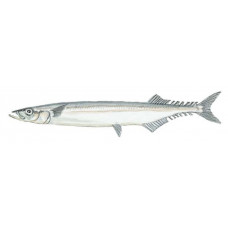Latin name
Cololabis saira
Other names
Pacific Saury, French: balaou; Italian: costardella; Norwegian: makrellejedde; Portuguese: agulhao; Turkish: zurna.
Identification
The snout is elongated. The upper jaw is not elongated, and the lower jaw forms a short flexible projection and is somewhat longer than the upper. There are five or six additional fins behind the dorsal fin and five or seven behind the anal fin. The jaws are beak-like, and are easily distinguished from needlefish and half-fish by the presence of five to seven fins behind the dorsal and anal fins, like a mackerel. Sauries as a group have fine scales, a relatively small mouth opening, small teeth, and no swim bladder. The coloration is silvery; the back is dark.
Distribution
Atlantic saury is found in the western Atlantic Ocean from the Gulf of St. Lawrence south to North Carolina and Bermuda. Pacific saury is found from Japan east to the Gulf of Alaska and south to Mexico. Off the Asian coast from the Okinawa Islands to eastern Kamchatka, including the waters of the northern East China Sea and the Sea of Japan. It penetrates the southern part of the Sea of Okhotsk.
Habitat
Swarming fish of the oceanic epipelagic. It occurs at temperatures from 8 to 25 °C, clusters are usually formed at a temperature of 12-16 °C. Avoids desalinated areas of the sea.
Size
Both species can reach a length of about 14 inches, but they are usually shorter. Maximum lengths are 38 cm and weights are 200 g. Most of the commercial saury stock in the Pacific Ocean consists of fish 22-32 cm long at 2-3 years of age. The saury reaches sexual maturity at 2 years of age. The age limit is 6 years.
Life history and Behavior
Eggs are oval, sticky, transparent, and 1.74-2.23 mm in size. The hatching larvae, 6.8-7 mm in length, are dispersed by currents. In a month, the larvae grow to 25-30 mm, and within two months to 60 mm.
Food and feeding habits
It feeds mainly on pelagic crustaceans, fish eggs and larvae. Its diet depends on the composition of plankton in its migratory area and varies with the seasons.
Reproduction
Spawning stretches from October to June (peak in January-March). In the Sea of Japan - from May to July. Water temperature during the spawning period is 18-21°С. Fertility is up to 22,000 eggs.
| Classification | |
| Phylum | Chordata |
| Class | Actinopterygii |
| Squad | Beloniformes |
| Family | Scomberesocidae |
| Genus | Cololabis |
| Species | C. saira |
| Features | |
| Conservation status | Least Concern |
| Habitat | Pelagic |
| Life span, years | 6 |
| Maximum body weight, kg | 0.18 |
| Maximum length, cm | 40 |
| Sailing speed, m/s | No information |
| Threat to people | Edible |
| Way of eating | Planktonophage |
Sauries
Tags: Sauries




